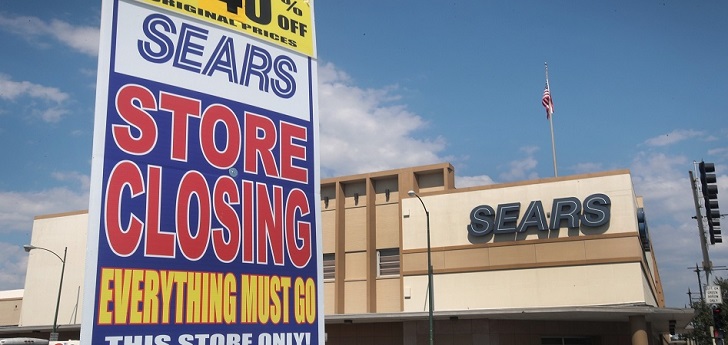2018, the year Sears filed for bankrupcy and department stores were put on guard
American department stores are deeply immersed in restructuring processes compelled by the brick crisis and the rise of pure players.

The 15th of October, Sears filed for Chapter 11. That move, carried out by one of the biggest companies in the sector, intensified the penury of the sector due to the relentless brick crisis and the dimension pure players like Amazon have managed to obtain.
Department stores, which were born back in the 19th Century but gained prestige and notoriety in the 20th, have reached the 21st one under challenging circumstances. That has been evidenced all through 2018, a year in which changes in leaderships, reduction of workforcLOSUces and points of sale’s closures have become part of everyday life.
Sears is just one of the victims of retail’s revolution, and so after accumulating a liability of 11.34 billion dollars (9.79 billion euros), it has had to seek bankruptcy court protection. Moreover, the company has dismissed Edward S. Lampert, its CEO, although the executive is still involved within the board of directors.
The first symptoms of Sears’ downturn came during 2005, after merging with Kmart Holding and having a total of more than 3,500 points of sale. Three years later, the company’s situation got complicated and in 2010 it took its account into the red.
Already scoring losses, Sears started to sell out some of its assets in order to keep cash flow up. The American group got rid of its Craftsman brand through a transaction carried out by the Stanley Black&Decker group valued in 900 million euros.
At the beginning of 2018, Sears accelerated its restructuring process with the purpose of reducing costs and saving about 200 million dollars. Under that framework, the company fired 220 workers from its central offices at Hoffman Estates, in the state of Illinois (USA). After filing for Chapter 11, Sears had access to credits of 300 and 350 million dollars, thus obtaining assets on hand with which it was able to pay suppliers in order to continue operating through the Christmas campaign.
The group estimates to end fiscal 2018 with less than 700 operating stores after closing over 142 ones during the year. In fact, the company has an amount of 825 closures registered ever since 2015. But red numbers are not only Sears’ business. The brick crisis has spread all over and it has unavoidably affected companies like JC Penney too. The group has also undergone severe changes in its structure with the intention to adapt to the current context, at the same time as it has reorganised its executive team through the appointment of Jill Soltau as general manager.
Department stores were born in the 19th Century and are now going through one of the most challenging periods of their history
JC Penney, with 116 years of existence on its back, has also strengthened its financial area with the incorporation of Michael Fung who, until October, was linked to Walmart. In line with what its competitors are doing, the company has continued resizing its network of stores throughout the year: from 2015 to 2018, the company has closed a total of 212 stores down.
Macy’s, on the other hand, has managed to keep up its rate although its turnover has actually reduced. In fact, in 2018, the company started a restructuring of its physical business that contemplated the drastic closure of square metres by means of renting spaces to thirds in all its North American centres.
Parallelly to the remediation of its network of stores, Macy’s strengthened its presence in the online channel putting omnichannel strategies at the centre. The company took a step forward in that direction appointing Naveen Krishn, who came from The Home Depor, to direct the technological transformation.
The decrease of sales, as well as stores closures, have been the year’s theme for the main department stores of the United States
During the last three years, the group has closed 124 points of sale. Notwithstanding, Macy’s has made up its mind on promoting the offline development of its Backstage chain, specialised in fashion sales from previous seasons, through shop-in-shops inside its facilities.
Kohl’s, with which in 2015 and 2016 faced a deep restructuring of its commercial network, returned to the path of growth in 2017 and has stayed in it all through 2018. The group fiercely increased its commitment on technology and it started to manage consumer data in order to design a clothing line targeted towards millennials. Nordstrom, the fifth biggest department store company in the United States in base to its turnover, has also managed to go back to profits in 2018, as well as to promote its fashion business through the appointment of Sam Lobban as new vice-president of men’s design and new concepts.


info@themds.com
Validation policy for comments:
MDS does not perform prior verification for the publication of comments. However, to prevent anonymous comments from affecting the rights of third parties without the ability to reply, all comments require a valid email address, which won’t be visible or shared.
Enter your name and email address to be able to comment on this news: once you click on the link you will find within your verification email, your comment will be published.